相互代词和指示代词
- 格式:docx
- 大小:15.50 KB
- 文档页数:3
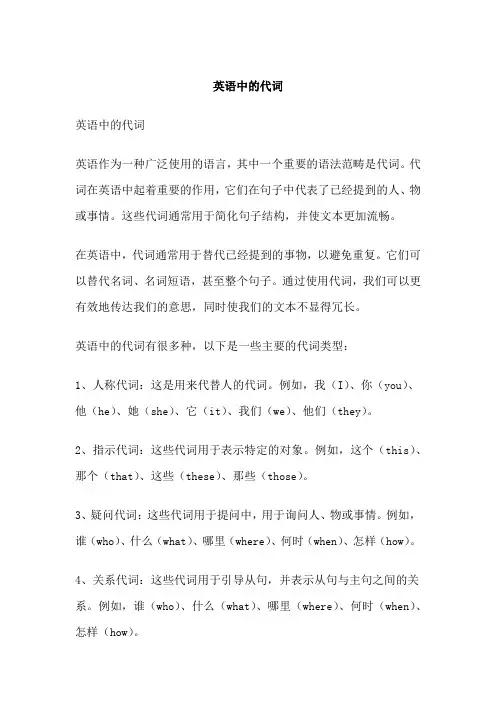
英语中的代词英语中的代词英语作为一种广泛使用的语言,其中一个重要的语法范畴是代词。
代词在英语中起着重要的作用,它们在句子中代表了已经提到的人、物或事情。
这些代词通常用于简化句子结构,并使文本更加流畅。
在英语中,代词通常用于替代已经提到的事物,以避免重复。
它们可以替代名词、名词短语,甚至整个句子。
通过使用代词,我们可以更有效地传达我们的意思,同时使我们的文本不显得冗长。
英语中的代词有很多种,以下是一些主要的代词类型:1、人称代词:这是用来代替人的代词。
例如,我(I)、你(you)、他(he)、她(she)、它(it)、我们(we)、他们(they)。
2、指示代词:这些代词用于表示特定的对象。
例如,这个(this)、那个(that)、这些(these)、那些(those)。
3、疑问代词:这些代词用于提问中,用于询问人、物或事情。
例如,谁(who)、什么(what)、哪里(where)、何时(when)、怎样(how)。
4、关系代词:这些代词用于引导从句,并表示从句与主句之间的关系。
例如,谁(who)、什么(what)、哪里(where)、何时(when)、怎样(how)。
5、不定代词:这些代词用于表示不确定的或未知的人、物或事情。
例如,一个(a)、一些(some)、任何(any)、每个人(everyone)。
正确地使用代词可以帮助我们创建清晰、易于理解的文本。
也需要注意不要误用或错用代词,以免引起混淆或误解。
总的来说,英语中的代词是一个重要的语言工具,可以帮助我们更好地表达自己的意思。
小学英语语法代词小学英语语法代词:介绍、用法和注意事项在英语学习过程中,代词起着非常重要的作用。
尤其是对于小学生,掌握代词的用法能够更好地理解和运用英语。
本文将为大家介绍小学英语语法中的代词,包括其特点、用法和注意事项,以帮助孩子们更准确地使用英语。
一、代词的种类和特点在小学英语语法中,常见的代词有:人称代词、物主代词、反身代词、指示代词和不定代词等。
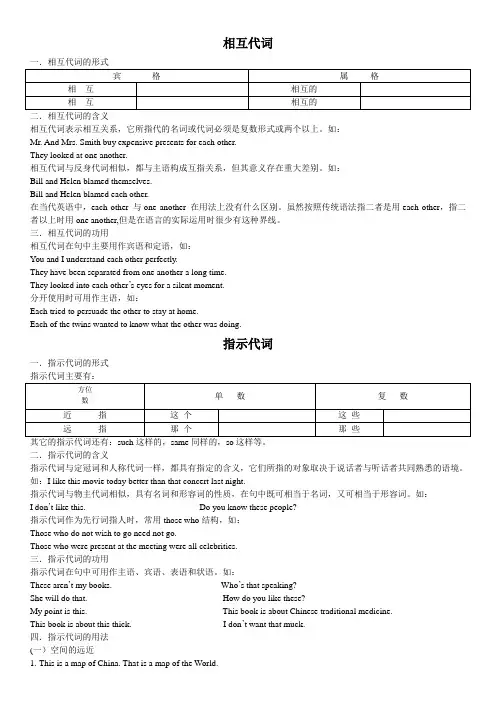
相互代词一.相互代词的形式宾格属格相互相互的相互相互的二.相互代词的含义相互代词表示相互关系,它所指代的名词或代词必须是复数形式或两个以上。
如:Mr. And Mrs. Smith buy expensive presents for each other.They looked at one another.相互代词与反身代词相似,都与主语构成互指关系,但其意义存在重大差别。
如:Bill and Helen blamed themselves.Bill and Helen blamed each other.在当代英语中,each other 与one another 在用法上没有什么区别。
虽然按照传统语法指二者是用each other,指二者以上时用one another,但是在语言的实际运用时很少有这种界线。
三.相互代词的功用相互代词在句中主要用作宾语和定语,如:You and I understand each other perfectly.They have been separated from one another a long time.They looked into each other’s eyes for a silent moment.分开使用时可用作主语,如:Each tried to persuade the other to stay at home.Each of the twins wanted to know what the other was doing.指示代词一.指示代词的形式指示代词主要有:方位单数复数数近指这个这些远指那个那些其它的指示代词还有:such这样的,same同样的,so这样等。
二.指示代词的含义指示代词与定冠词和人称代词一样,都具有指定的含义,它们所指的对象取决于说话者与听话者共同熟悉的语境。
如:I like this movie today better than that concert last night.指示代词与物主代词相似,具有名词和形容词的性质,在句中既可相当于名词,又可相当于形容词。
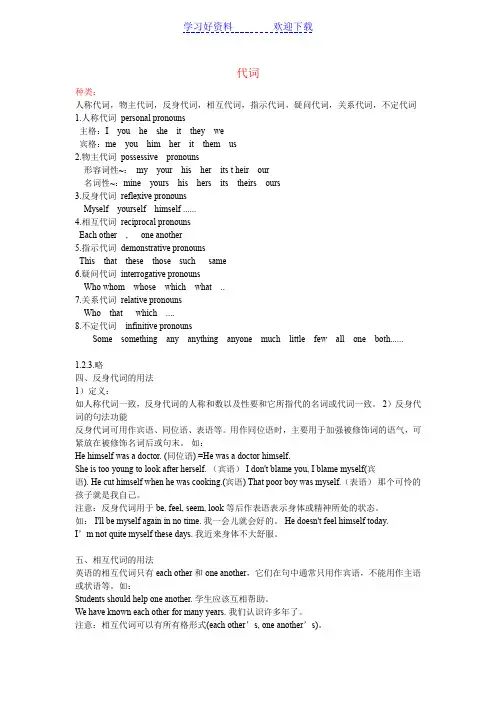
代词种类:人称代词,物主代词,反身代词,相互代词,指示代词,疑问代词,关系代词,不定代词1.人称代词personal pronouns主格:I you he she it they we宾格:me you him her it them us2.物主代词possessive pronouns形容词性~:my your his her its t heir our名词性~:mine yours his hers its theirs ours3.反身代词reflexive pronounsMyself yourself himself ......4.相互代词reciprocal pronounsEach other , one another5.指示代词demonstrative pronounsThis that these those such same6.疑问代词interrogative pronounsWho whom whose which what ..7.关系代词relative pronounsWho that which ....8.不定代词infinitive pronounsSome something any anything anyone much little few all one both......1.2.3.略四、反身代词的用法1)定义:如人称代词一致,反身代词的人称和数以及性要和它所指代的名词或代词一致。
2)反身代词的句法功能反身代词可用作宾语、同位语、表语等。
用作同位语时,主要用于加强被修饰词的语气,可紧放在被修饰名词后或句末。
如:He himself was a doctor. (同位语) =He was a doctor himself.She is too young to look after herself. (宾语) I don't blame you, I blame myself(宾语). He cut himself when he was cooking.(宾语) That poor boy was myself.(表语)那个可怜的孩子就是我自己。
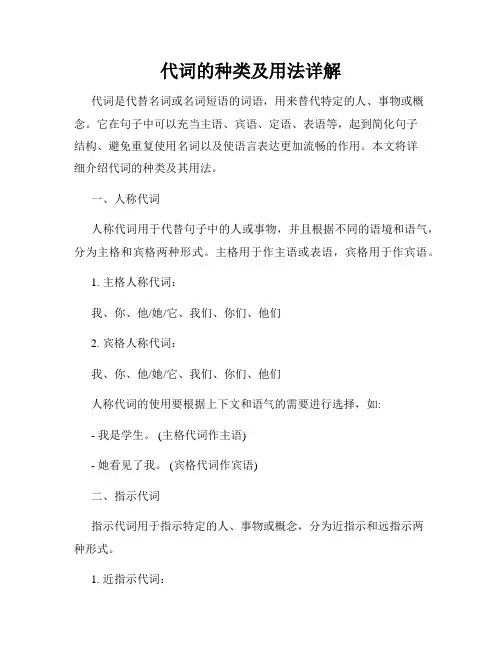
代词的种类及用法详解代词是代替名词或名词短语的词语,用来替代特定的人、事物或概念。
它在句子中可以充当主语、宾语、定语、表语等,起到简化句子结构、避免重复使用名词以及使语言表达更加流畅的作用。
本文将详细介绍代词的种类及其用法。
一、人称代词人称代词用于代替句子中的人或事物,并且根据不同的语境和语气,分为主格和宾格两种形式。
主格用于作主语或表语,宾格用于作宾语。
1. 主格人称代词:我、你、他/她/它、我们、你们、他们2. 宾格人称代词:我、你、他/她/它、我们、你们、他们人称代词的使用要根据上下文和语气的需要进行选择,如:- 我是学生。
(主格代词作主语)- 她看见了我。
(宾格代词作宾语)二、指示代词指示代词用于指示特定的人、事物或概念,分为近指示和远指示两种形式。
1. 近指示代词:这、这个、这些2. 远指示代词:那、那个、那些指示代词通常与名词连用,用于指示离说话人或写作人近或远的事物,如:- 这是我的书。
(近指示代词连用名词)- 那些是我曾经去过的地方。
(远指示代词连用名词)三、疑问代词疑问代词用于提问特定的人、事物或概念,用于构成疑问句。
1. 主格疑问代词:谁、什么2. 宾格疑问代词:谁、什么疑问代词与疑问词连用,用于提问特定信息,如:- 你是谁? (主格疑问代词作宾语)- 你要买什么? (宾格疑问代词作宾语)四、物主代词物主代词用于表示所属关系,代替名词所表示的所有者,分为形容词性物主代词和名词性物主代词两种形式。
1. 形容词性物主代词:我的、你的、他/她/它的、我们的、你们的、他们的2. 名词性物主代词:我的、你的、他/她/它的、我们的、你们的、他们的形容词性物主代词和名词性物主代词的使用要根据名词的性质和上下文进行选择,如:- 这是我的书。
(形容词性物主代词修饰名词)- 这本书是我的。
(名词性物主代词作主语)五、反身代词反身代词用来表示动作的承受者和施事者是同一人,用于强调动作的自觉性和自发性。
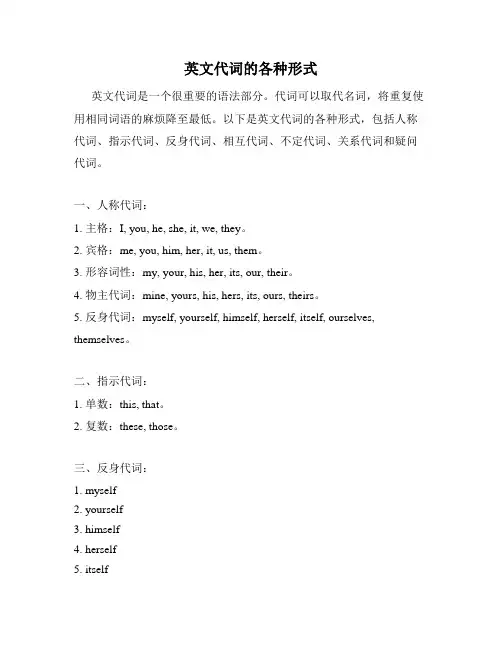
英文代词的各种形式英文代词是一个很重要的语法部分。
代词可以取代名词,将重复使用相同词语的麻烦降至最低。
以下是英文代词的各种形式,包括人称代词、指示代词、反身代词、相互代词、不定代词、关系代词和疑问代词。
一、人称代词:1. 主格:I, you, he, she, it, we, they。
2. 宾格:me, you, him, her, it, us, them。
3. 形容词性:my, your, his, her, its, our, their。
4. 物主代词:mine, yours, his, hers, its, ours, theirs。
5. 反身代词:myself, yourself, himself, herself, itself, ourselves, themselves。
二、指示代词:1. 单数:this, that。
2. 复数:these, those。
三、反身代词:1. myself2. yourself3. himself4. herself5. itself6. ourselves7. yourselves8. themselves四、相互代词:1. each other2. one another五、不定代词:1. some2. any3. no4. anybody/anyone5. somebody/someone6. nobody/no one7. everybody/everyone六、关系代词:1. that2. which3. who4. whom5. whose七、疑问代词:1. what2. who3. whom4. which5. whose以上是英文代词的各种形式。
对于想要成功学习英文的人来说,掌握这些代词是必不可少的。
对于英文写作、口语和听力理解来说,代词是非常重要的。
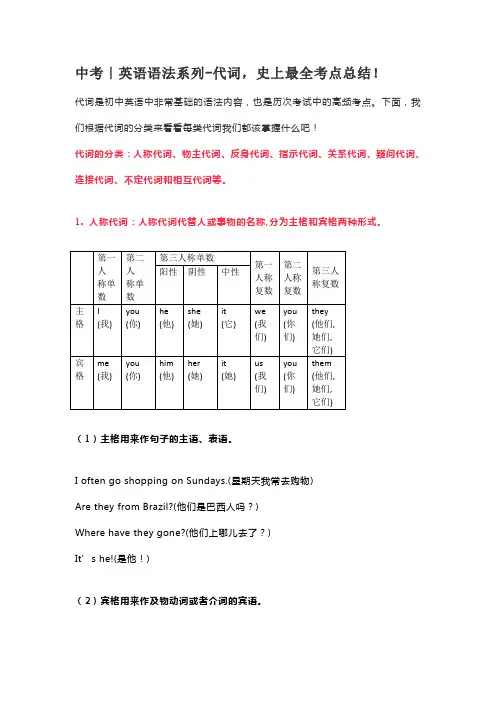
中考|英语语法系列-代词,史上最全考点总结!代词是初中英语中非常基础的语法内容,也是历次考试中的高频考点。
下面,我们根据代词的分类来看看每类代词我们都该掌握什么吧!代词的分类:人称代词、物主代词、反身代词、指示代词、关系代词、疑问代词、连接代词、不定代词和相互代词等。
1. 人称代词:人称代词代替人或事物的名称,分为主格和宾格两种形式。
(1)主格用来作句子的主语、表语。
I often go shopping on Sundays.(星期天我常去购物)Are they from Brazil?(他们是巴西人吗?)Where have they gone?(他们上哪儿去了?)It’s he!(是他!)(2)宾格用来作及物动词或者介词的宾语。
Who teaches you English this year?(今年谁教你们的英语?)Help me!(救救我!)We often write letters to her.(我们常给他写信)(3)人称代词作表语或者放在比较状语从句连词than或as之后时,可以用主格形式,也可以用宾格形式,口语中大多用宾格。
–It’s I/me.(是我。
)(4)三个不同人称同时出现,或者主语中包含“我”时,按照“you→he→I”的顺序表达。
Both he and I are working at that computer company.(我和他都在那家电脑公司上班)–Who will go there?(谁要去那儿?)–You and me.(你和我)(5)人称代词it除了可以指人指物之外,还可以表示“时间、天气、温度、距离、情况”等含义,此外还可以作“非人称代词”使用,替代作主语或者宾语的不定式、动名词或者名词性从句。
--What’s the time?(几点啦?)–It’s 12:00.(12点了。
)It’s a long way to go.(那可要走好长的路。
)It took him three days to clean his house.(打扫屋子花了他三天的时间。
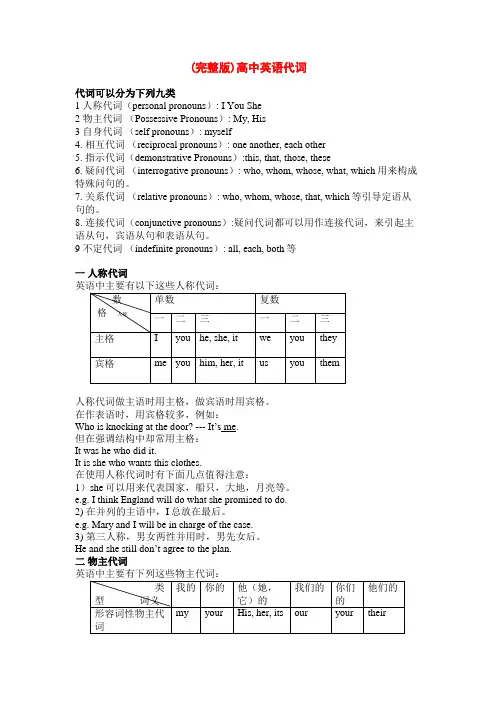
(完整版)高中英语代词代词可以分为下列九类1 人称代词(personal pronouns): I You She2 物主代词(Possessive Pronouns): My, His3 自身代词(self pronouns): myself4. 相互代词(reciprocal pronouns): one another, each other5. 指示代词(demonstrative Pronouns):this, that, those, these6. 疑问代词(interrogative pronouns): who, whom, whose, what, which用来构成特殊问句的。
7. 关系代词(relative pronouns): who, whom, whose, that, which等引导定语从句的。
8. 连接代词(conjunctive pronouns):疑问代词都可以用作连接代词,来引起主语从句,宾语从句和表语从句。
9 不定代词(indefinite pronouns): all, each, both等一人称代词人称代词做主语时用主格,做宾语时用宾格。
在作表语时,用宾格较多,例如:Who is knocking at the door? --- It’s me.但在强调结构中却常用主格:It was he who did it.It is she who wants this clothes.在使用人称代词时有下面几点值得注意:1)she可以用来代表国家,船只,大地,月亮等。
e.g. I think England will do what she promised to do.2) 在并列的主语中,I总放在最后。
e.g. Mary and I will be in charge of the case.3) 第三人称,男女两性并用时,男先女后。
He and she still don’t agree to the plan.二物主代词1.1)表语Whose dictionary is this? ----it’s mine.2) 主语Ours is a big family.3) 宾语Let’s clean their room first and ours later.2. “of +名词性物主代词”可用作定语That car of hers is always breaking down.= Her car is …….三11)作宾语I can’t express myself in English.2) 作表语I am not quite myself these days. 我近来身体不大舒服。
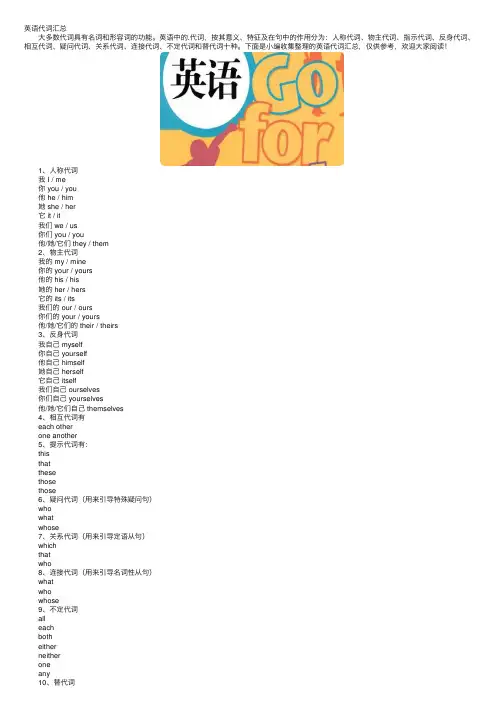
英语代词汇总 ⼤多数代词具有名词和形容词的功能。
英语中的.代词,按其意义、特征及在句中的作⽤分为:⼈称代词、物主代词、指⽰代词、反⾝代词、相互代词、疑问代词、关系代词、连接代词、不定代词和替代词⼗种。
下⾯是⼩编收集整理的英语代词汇总,仅供参考,欢迎⼤家阅读! 1、⼈称代词 我 I / me 你 you / you 他 he / him 她 she / her 它 it / it 我们 we / us 你们 you / you 他/她/它们 they / them 2、物主代词 我的 my / mine 你的 your / yours 他的 his / his 她的 her / hers 它的 its / its 我们的 our / ours 你们的 your / yours 他/她/它们的 their / theirs 3、反⾝代词 我⾃⼰ myself 你⾃⼰ yourself 他⾃⼰ himself 她⾃⼰ herself 它⾃⼰ itself 我们⾃⼰ ourselves 你们⾃⼰ yourselves 他/她/它们⾃⼰ themselves 4、相互代词有 each other one another 5、提⽰代词有: this that these those those 6、疑问代词(⽤来引导特殊疑问句) who what whose 7、关系代词(⽤来引导定语从句) which that who 8、连接代词(⽤来引导名词性从句) what who whose 9、不定代词 all each both either neither one any 10、替代词 指明代替任何特定名词或形容词的代词叫做不定代词。
【英语代词汇总】。
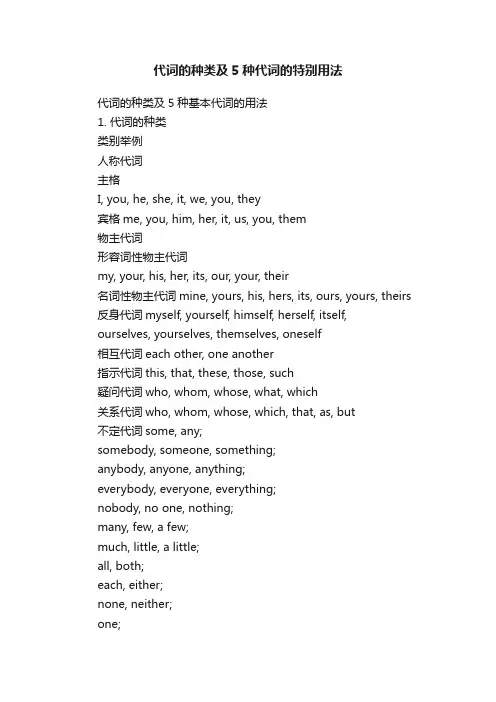
代词的种类及5种代词的特别用法代词的种类及5种基本代词的用法1. 代词的种类类别举例人称代词主格I, you, he, she, it, we, you, they宾格me, you, him, her, it, us, you, them物主代词形容词性物主代词my, your, his, her, its, our, your, their名词性物主代词mine, yours, his, hers, its, ours, yours, theirs 反身代词myself, yourself, himself, herself, itself, ourselves, yourselves, themselves, oneself相互代词each other, one another指示代词this, that, these, those, such疑问代词who, whom, whose, what, which关系代词who, whom, whose, which, that, as, but不定代词some, any;somebody, someone, something;anybody, anyone, anything;everybody, everyone, everything;nobody, no one, nothing;many, few, a few;much, little, a little;all, both;each, either;none, neither;one;other, another2. 人称代词的用法(1) 人称代词主格在句中作主语:The light is bad here. I can’t see clearly.这儿的光线不好,我看不清。
She hesitated a moment, and then sat down beside me.她犹豫了一会儿,然后在我身边坐下来。
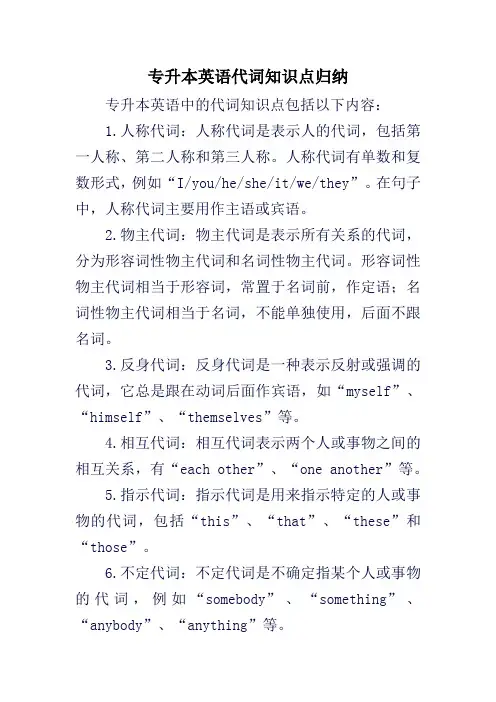
专升本英语代词知识点归纳
专升本英语中的代词知识点包括以下内容:
1.人称代词:人称代词是表示人的代词,包括第一人称、第二人称和第三人称。
人称代词有单数和复数形式,例如“I/you/he/she/it/we/they”。
在句子中,人称代词主要用作主语或宾语。
2.物主代词:物主代词是表示所有关系的代词,分为形容词性物主代词和名词性物主代词。
形容词性物主代词相当于形容词,常置于名词前,作定语;名词性物主代词相当于名词,不能单独使用,后面不跟名词。
3.反身代词:反身代词是一种表示反射或强调的代词,它总是跟在动词后面作宾语,如“myself”、“himself”、“themselves”等。
4.相互代词:相互代词表示两个人或事物之间的相互关系,有“each other”、“one another”等。
5.指示代词:指示代词是用来指示特定的人或事物的代词,包括“this”、“that”、“these”和“those”。
6.不定代词:不定代词是不确定指某个人或事物的代词,例如“somebody”、“something”、“anybody”、“anything”等。
7.关系代词:关系代词用来引导定语从句,包括“who”、“whom”、“whose”、“that”等。
以上是专升本英语中代词的主要知识点归纳。
理解和掌握这些知识点有助于在英语学习中更好地理解和运用代词。
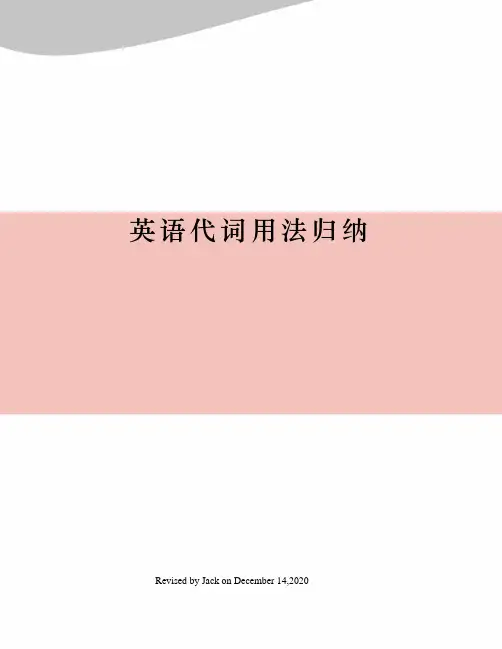
英语代词用法归纳 Revised by Jack on December 14,2020英语代词的用法全归纳一、定义与分类代词是代替名词及起名词作用的短语或句子的词。
代词根据其意思和用法可分为人称代词、物主代词、反身代词、指示代词、相互代词、疑问代词、连接代词、关系代词、不定代词九类。
综观历年高考情况,在这九类代词中,不定代词一直是高考英语的重点。
二、人称代词,物主代词,反身代词用法概述这三种代词都有人称(一、二、三人称)的变化、数(单、复数)的变化,以及性(阴性、阳性、中性)的变化。
其中,人称代词除了这三种变化外,还有格(主格、宾格)的变化。
物主代词又包括两种形式:形容词性物主代词和名词性物主代词。
特别注意:形容词性物主代词its没有相应的名词性物主代词。
这三种代词的形式变化表如下:三、人称代词的用法1)定义:人称代词是用来指代人、动物或事物的代词。
它必须在人称(第一人称、第二人称、及第三人称)、数(单数、复数)以及性(阴性、阳性、中性)三方面与被指代的名词一致。
如:I am a student. Tom is a boy, and he is a student.Mary is very pretty, and she likes singing.The boys are students, and they are in the room.The doy is small. It is Tom's.2)人称代词的句法功能A) 人称代词有主格和宾语之分:主格用作主语,宾格用作宾语。
B) 人称代词的主格形式在在句中作主语和表语。
如: I like music(主语). She is a teacher.(主语)She and I are good friends(主语).Neither she nor I am student.——I saw the boys this morning.——Are you sure it was they(表语)It might have been she.C) 人称代词的宾格在句子作动词的宾语,或者介词的宾语。
代词的用法与指代关系代词是指用来代替名词的一类词语,它可以简化表达,增加句子的流畅度。
在英语中,代词具有丰富的用法和指代关系。
了解和掌握代词的正确用法,对于提升英语写作和交流的准确性和效率尤为重要。
本文将介绍一些常见的代词用法及其指代关系,以便读者更好地理解和运用代词。
一、人称代词人称代词是用来代替特定人或特定群体的词语。
它根据在句子中的不同角色和人称关系而变化。
常见的人称代词有:I(我),you(你/您),he(他),she(她),it(它),we(我们),they(他们/她们/它们)。
1. 第一人称代词第一人称代词用于指代说话人自己。
例如:I am a student.(我是一名学生。
)在交流和写作中,第一人称代词常用于表达个人观点和经历。
2. 第二人称代词第二人称代词用于指代和称呼对方。
例如:Can you help me?(你能帮助我吗?)第二人称代词在口语和书面语中广泛使用,用于与对方建立联系和进行交流。
3. 第三人称代词第三人称代词用于指代不在场的人或物体,并根据其性别和数的不同而变化。
例如:He is my brother.(他是我的兄弟。
)She loves playing basketball.(她喜欢打篮球。
)It is a cat.(它是一只猫。
)They are my friends.(他们是我的朋友。
)第三人称代词在描述他人特征和引用对方观点时常被使用。
二、指示代词指示代词用于指示或引用特定的人或物体。
它们根据离说话人的远近和与说话人的关系而变化。
常见的指示代词有:this(这),that (那),these(这些),those(那些)。
1. 单数指示代词单数指示代词用于指示离说话人近的人或物体。
例如:This is my book.(这是我的书。
)在写作和演讲中,单数指示代词常用于介绍自己或谈论当前正在提及的事物。
2. 复数指示代词复数指示代词用于指示离说话人远的人或物体。
代词高考对代词的考查主要是人称代词、物主代词、反身代词、指示代词、不定代词、疑问代词和关系代词等;设置特定的语境,对代词的数、性、格的变化进行考查仍然是高考的热点;Ⅰ代词的分类1.人称代词:主格I, we, you, he, she, it, they宾格me, us, you, him, her, it, them2.物主代词:形容词性my, our, your, his, her, its, their名词性mine, ours, yours, his, hers, its, theirs3.反身代词:单数myself, yourself, himself, herself, itself复数ourselves, yourselves, themselves4.相互代词:each other 两者之间相互;one another 两者以上的相互5.指示代词:this, that, these, those6.疑问代词:who, whom, whose, which, what7.关系代词:who, whom, whose, that指人,which, that, as, whose 指物8.不定代词:all, each, either, neither, both, none, other, another, something, everything, nothing somebody, everybody, nobody someone, everyone, no one, many, much, few, less一、人称代词单数复数第一人称第二人称第三人称第一人称第二人称第三人称人主I you he,she,itwe you they称代词格宾格me you him,her,itus you them人称代词的用法1.人称代词的主格在句子中作主语或主语补足语;如:John waited a while but eventually he went home.约翰等了一会儿,最后他回家了; John hoped the passenger would be Mary and indeed it was she.说明:在复合句中,如果主句和从句主语相同,代词主语要用在从句中,名词主语用在主句中;When he arrived,John went straight to the bank.约翰一到就直接去银行了;2.人称代词的宾格在句子中作宾语或介词宾语,但在口语中也能作主语补语,第一人称在省略句中,还可以作主语;如:I saw her with them;at least,I thought it was her.第一个her作动词宾语,them作介词宾语,第二个her作表语—Who broke the vase谁打碎了花瓶—Me.我;3.人称代词之主、宾格的替换1宾格代替主格在简短对话中,当人称代词单独使用或在not 后,多用宾语;—I like English.;—Me too.—Have more wine—Not me.;在表示比较的非正式的文体中,常用宾格代替主格; 但如果比较状语的谓语保留,则主语只能用主格;He is taller than I/me. He is taller than I am.2主格代替宾格在介词but,except后,有时可用主格代替宾格;在电话用语中常用主格;—I wish to speak to Mary.;—This is she.注意:在动词be 或to be后的人称代词视其前面的名词或代词而定;I thought it was she.我以为是她;主格——主格I thought it to be her.宾格——宾格I was taken to be she.我被当成了她;主格——主格They took me to be her.他们把我当成了她;宾格——宾格4.代词的指代问题1不定代词anybody,everybody,nobody,anyone, someone, everyone,no one, 及whoever和person在正式场合使用时,可用he,his,him代替;如:Nobody came,did he2动物名词的指代一般用it或they代替,有时也用he,she,带有亲切的感情色彩;如:Give the cat some is hungry.;3指代车或国家,船舶的名词,含感情色彩时常用she;5.并列人称代词的排列顺序1单数人称代词并列作主语时,其顺序为:第二人称→ 第三人称→第一人称,即you→ he/she; it → I;如:You,he and I should return on time.你,他还有我应该按时回来;2复数人称代词作主语时,其顺序为:第一人称→ 第二人称→第三人称,即we→you→they;在下列情况中,第一人称放在前面;在承认错误,承担责任时;It was I and John that made her angry.是我和约翰惹她生气了;在长辈对晚辈,长官对下属说话时,如长官为第一人称,如:I and you try to finish it.并列主语只有第一人称和第三人称时;当其他人称代词或名词被定语从句修饰时;二、物主代词物主代词是表示所有关系的代词,也可叫做代词所有格;物主代词分形容性物主代词和名词性物主代词两种,其人称和数的变化见下表;单数复数第一人称第二人称第三人称第一人称第二人称第三人称物主代词形容词性my your his,her,its our your their名词性mine your shis,hers,its ours yours theirsOur school is here,and theirs is there.我们的学校在这儿,他们的在那儿;1.物主代词的用法1物主代词既有表示所属的作用又有指代作用;如:John had cut his finger; apparently there was a broken glass on his desk.2物主代词有形容词性my,your等和名词性mine,yours等两种,形容词性的物主代词属于限定词;名词性的物主代词在用法上相当于省略了中心名词的’s属格结构;如:Jack’s cap意为The cap is Jack’s;His cap意为The cap is his;2.名词性物主代词的句法功能1作主语;如:May I use your pen Yours works better.2作宾语;如:I love my motherland as much as you love yours.3作介词宾语;如:You should interpret what I said in my sense of the word,not inyours.4作表语;如:The life I have is ’s ’s yours.3.双重所有格物主代词不可与a,an,this,that,these,those,some,any,several,no,each,every,such,another,which等词一起前置,修饰一个名词,而必须用双重所有格;公式为:a,an,this,that+名词+of+名词性物主代词;三、指示代词指示代词表示“那个”“这个”“这些”“那些”等指示概念的代词;指示代词有this,that,these,those等;如:That is a good idea.指示代词的用法1.指示代词分单数this/that和复数these/those两种形式,既可作限定词又可作代词;2.指示代词的句法功能;1作主语;如:This is the way to do it.2作宾语;如:I like this better than that.3作表语;如:My point is this.4作介词宾语;如:I don’t say no to that.There is no fear of that.说明1:指示代词在作主语时可指物也可指人,但作其他句子成分时只能指物,不能指人;如:对That is my teacher.那是我的老师;that作主语,指人对He is going to marry this girl.他要和这个姑娘结婚;this作限定词错He is going to marry this.this作宾语时不能指人对I bought this.我买这个;this指物,可作宾语说明2:that和those可作定语从句的先行词,但this和these不能,同时,在作先行词时,只有those可指人,试比较:对He admired that which looked beautiful.对He admired those who looked beautiful.他赞赏那些外表漂亮的人;those 指人错He admired that who danced well.that 作宾语时不能指人对He admired those who danced well.他赞赏跳舞好的人;those 指人对He admired those which looked beautiful.他赞赏那些外表漂亮的东西;those指物四、反身代词表示“我自己”“你自己”“他自己”“我们自己”“你们自己”和“他们自己”等的代词,叫做自身代词,也称为“反身代词”;如:She was talking to herself.她自言自语;反身代词单数复数第一人称第二人称第三人称第一人称第二人称第三人称myself yourself himselfherselfitselfourselves yourselves themselves反身代词的用法1.作宾语,如1有些动词需有反身代词,如absent,bathe,amuse,blame,dry,cut,enjoy,hurt,introduce,behave等;如:We enjoyed ourselves very much last night.Please help yourself to some fish.2用于及物动词+宾语+介词,如:take pride in,be annoyed with,help oneself to sth 等;I could not dressmyselfup at that time.注:有些动词后不跟反身代词,如:get up,stand up,wake up等;Please sit down.2.用作表语;如;I am not myself today.3.用作同位语;如The thing itself is not important.4.在不强调的情况下,but,except,for 等介词后宾语用反身代词或人称代词宾格均可;注意:1反身代词本身不能单独作主语;错Myself drove the car.对I myself drove the car.我自己开车;2但在and,or,nor连接的并列主语中,第二个主语可用反身代词,特别是myself 作主语;Charles and myself saw it.查尔斯和我看见了这件事;五、相互代词表示相互关系的代词叫相互代词,有each other和one another两个词组;他们表示句中动词所叙述的动作或感觉在涉及的各个对象之间是相互存在的;如:It is easy to see that the people of different cultures have always copied each other.,相互借鉴的相互代词宾格each other,one another所有格each other’s,one another’s相互代词的句法功能1.作动词宾语;如:People should love one another.人们应当彼此相爱;2.可作介词宾语;Dogs bark,cocks crow,frogs croak to each other.犬吠、鸡鸣、蛙儿对唱;说明:传统语法认为,相互关系存在于两个人或物之间用each other, 存在于两个以上人和物之间用one another;现代英语中,两组词交替使用的实例也很多;He put all the books beside each other/one another.他把所有书并列摆放起来; Usually these small groups were independent of each other.这些小团体通常是相互独立的;3.相互代词可加’s构成所有格;如:The students borrowed each other’s notes.六、不定代词不是指明代替任何特定名词的代词叫做不定代词;常见的不定代词有all,both,each,every等,以及含有some,any,no等的合成代词,如anybody,something,no one;这些不定代词大都可以代替名词和形容词,在句中作主语、宾语、表语和定语,但none和由some,any,no等构成的复合不定代词只能作主语、宾语或表语;every 和no只能作定语;如:—Do you have a car— Yes,I have one.—I don’t know any of them.他们,Ⅱ代词的用法1. nothing, none, no onenone作为代词,最常用来表示数量,它可以是一个可数的概念how many也可以是一个不可数的概念how much,或者any引起的问题;而nothing是相对于something有某物什么都没有,它回答的是“What is in/on...”的问题;而no one=nobody没有人,它回答的是“Who did that”谁……或是anyone有没有人的问题;2. one, ones, that, those, it1one和ones可以用来代替前面提到过的可数名词,one代单数,ones代复数,其中:两者都可以指代物只要是可数one前面一般不加a,因为它本身有“一个”的意思,但如果one前面有形容词修饰,则需要加a/an;one可以单独使用,意思为“任何人”;例如:—Shall we have a rest—Didn’t we just have one因为one=a somethingOne should always believe in oneself.2that与those:that可以代替前面提到的不可数名词或可数名词单数相当于the one;而those 代替前面提到的复数名词,有时可以用the ones替换;例如:The population of China is bigger than that of India. that=the populationThe boy told his story and that of the girl next room.that=the storyThe cell phones we made nowadays are better than those/the ones made 2 years ago.those=the cell phones=the ones3one和it:两者都可以用来代替前面出现过的单数名词,one指这类东西中的任何一个,指类属,泛指;it指前面所指的同一物;例如:I need a pen to sign my name. Can I have one one =a pen I cannot find my new pen. Have you seen itit指那支新钢笔3. another, the other, other, others, the others1another和the other:两者都是“另一个”的意思,但数量上有区别:用another指两个以上的数量,而the other只指两个中的另一个,例如:He has three brothers, one is a teacher, another is a doctor and the third is an engineer.注:another除了可以作代词,还可以用作形容词;这里有必要区别another, the other和more的用法:①another:another表“另一个”时只跟可数名词单数,而表“另外的、额外的、附加的”时,可跟带有few或具体数字的复数名词,此时可把“数词+复数名词”看作是一个整体;例如:—Have you finished your report yet—No,I will finish it in another 10 minutes.There is room for another few people in the back of the bus.②other:表“另外的”接复数名词,如与具体数词连用,则置于数词之后,但与定冠词the连用时,other要放在数词前;例如:Tony is going camping with two other little boys next Sunday.Do you know where he found the other two photos③more:more一般位于数词之后,名词之前,有时也可置于名词之后;例如:One more stepOne step more,and I’ll shoot you.Where shall we be in ten more yearsmore除跟数词外,还可与many, a little,a few,a lot,several等词连用,例如:There are many more dictionaries on the desk.Would you like some more tea2 others, the othersothers是相对于some来说的:some...some....others... 一些……一些……另一些……是泛指;而the others是特指另一些,相对于ones 可以理解为one, the other 的复数;例如:Class 1 are cleaning the classroom. Some are sweeping the floor, some are cleaning the window, and others are washing the blackboard. 泛指There are only 20 students in the classroom, where are the others.特指4. both, other, neither, each, any, allboth:两者都,谓语动词用复数;either:两者中间的任何一个,谓语动词用单数;neither:两者中间无任何一个,谓语动词多用单数,也可以用复数;each:两个或两个以上中的每一个,谓语动词用单数;any:三者或三者以上中的任何一个,谓语动词用单数;all:三者或三者以上全部;5. some, any, nosome属于肯定词,主要用于肯定句中,但当说话人期待肯定回答时,也可以用于疑问句中;例如:Could I have some more tea, please Would you like some more coffeeany属于非肯定词,主要用于否定句、疑问句或条件句中;它可以与形容词的比较级连用;例如:Don’t come any closer,or I’ll shootno属于否定词,用于否定句中:no+可数名词单数=not a/an no+可数名词复数=not any;例如:There is no such thing as a free lunch in the world.考点诠释纵观历年高考试题,代词的主要考点主要集中在以下几个方面:不定代词one,the one,ones,the ones;物主代词的用法;人称代词主格和宾格的用法;表示两者和多者的不定代词的比较;指示代词this,that,these,those,it的用法;another,theothers,else;the rest的用法;every-,some-,any-,no-与-thing,-one,-body构成的复合不定代词的用法;考点1 人称代词一般地说人称代词作主语时用主格;作宾语时用宾格;作定语时用形容词性物主代词;名词性物主代词可以代替“形容词性物主代词+名词”;但口语中,在无动词的句子里,往往用代词的宾格形式;1.用于无谓语的句子中一Dpes any of you know why Jack hasn’t come yet一Me.;答语如果带谓语,就得用主格,如:I can.和I do,too./So do I.2.表示惊奇、猜疑、反问、不满、厌烦等①Do you have good eyesight,young man一MeI can see a sparrow two hundred paces away.②WhatMe fight a big chap like himNot me3.代替as,than等连词之后的主格多用于口语中,尤其用于句末①I’m not as tall as himhe.;②She is much more careful than meI.她比我细心得多;当这类人称代词带有all,both等同位语时,用宾格的形式就更为常见了;如:He works harder than us a11.典例:Our neighbers gave a baby bird yesterday that hurt when it fell from its nest. A.us;it B.us;itself C.ourselves;itself D.ourselves;it考点2指不代词1.this/these,that/thosethis,these指代下面要说的内容;that,those指代上面陈述过的内容;如:①What I’d like to say about how to improve our spoken English is like this.②That’s a11.Thank you.③Salaries are higher here than those inmy hometown.2.一些习惯说法中this和that的用法比较固定①Who’s that你是谁②This is Mary.③11at’s all right/OK.;对感谢的答语④nat’S nothing.;对道歉的答语‘⑤That’s that.表示决定不能更改⑥That’S a11.就这些了;⑦That is…那就是……3.this,that有时可以用作副词,意为“这么,那么”,用在形容词或副词前作状语,表示程度It isn’t that cold.还没那么冷;考点3不定代词以下是几组易混不定代词:1.some类不定代词与any类不定代词1some类不定代词多用于肯定句中;any类的多用于疑问句、否定句和条件状语从句中;如:Raise your hands if you have any questions.如果你们有问题,请举手;2但在表示客气的请求或希望对方给予肯定回答的疑问句中,要用some类的不定代词;如:Would you like something to drink你要喝点什么吗3any类的不定代词用在肯定句中,表示“任何一个;任何事情;无论什么”;如:She promised that she could do anything for you.她许诺能为你做任何事情;2.all,both,neither,none1all指三者或三者以上“都”,both指两者“都”;如:①Bothofhis hands were wounded.②Allofhis fingers were wounded.2neither表示“两个都不”,常和of连用,放在带有冠词、物主代词或指示代词的复数名词之前,作主语时,谓语动词可以用单数或复数;none表示三个或三个以上“都不”,可用于人,也可用于物,后可接of短语,与复数名词、代词或单数集合名词连用作主语,指人时,谓语动词用单、复数皆可;指物时,只用第三人称单数形式;如:①Neither of the twins is/are cor rect.②None of us has/have ever been to the Great wall.3.any,either,each,every1any一般用于否定句、疑问句和条件句中;也可用在肯定句中,以加强语气,表示“任一”的概念;还可以用来修饰可数名词单数,表示三者或三者以上中的“任何一个”;如:I didn’t eat any meat.我一点儿肉也没吃;4.no,none,nothing,nobody1no不能单独使用,相当于not a或not any,作定语修饰可数名词或不可数名词;如:You have no sympathy for the sufferings of others.你对别人的痛苦没有同情心;2none既可以指人,也可以指物,侧重指三者或三者以上的人或物,用于回答how many/much引导的疑问句,可与介词of连用;如:①None of the books is suitable for the young.这些书都不适合年轻人读;②一How many people are there in the room一None.没人;3nobody指人,用于回答who引导的疑问句;nothing指物,用于回答what引导的疑问句;如:一Who is in the room谁在屋内一Nobody.没有人;5.it,one,ones, that和those1it特指上文所提到的同一个物,它所代替的名词常由the,this,that等修饰;one指上文提到的同类事物中的一个,不特指,被指代的名词通常由不定代词some或any修饰;如:①Where is that bookI can’t find it.那本书在哪儿我找不到它;②I haven’t got any erasers.Will you please give me one我没有橡皮,请你给我一块好吗(2)one与that都可用来代替上文中出现的名词,one前要用定冠词the,有时that和the one可互换使用;如:The book isn’t so interesting as the one/that you borrowed.3但that和one在多数情况下是不能互换的,主要区别在于:that既可代替可数名词,也可代替不可数名词,常要求有后置定语,一般不指人,复数形式为those;one只能代替可数名词单数,复数形式为ones;当可数名词前有形容词修饰时,只能用one,不用that;当of短语作可数名词的后置定语时,用that,不用one;如:①The best cigarettes are those from Yunnan.②The boy told me his story and that of the girl next door.Your coat is blue,and my new one is green.你的大衣是蓝色的,我的新大衣是绿色的;4the ones用来代替上文提到的特指的复数名词,有时可以用those代替,尤其在有后置定语的情况下;如:The books on the desk are better than those/the ones under the desk.6.another,other,others,more1another既可以单独使用,也可以用于单数名词前,泛指三者或三者以上中的“另外一个人或物”;还可以用“another+数量词+复数名词”,表示”再,又”;如:①was there another way out②we’d better wait another five minutes.特别提示表示“另外一个学生”只能用another student,不能说成another one student;2other不能单独使用,应用于复数名词前,表示另外的某些人或物,也可以用在some,any,no之后,或具体数词之后,再接名词,构成”不定代词或具体数词+other+名词”;接单数名词时,还可以用在冠词the后,特指两个人或物中的另外一个可以省略为the other,或特指另外的某些人或物可以省略为theothers,others泛指”其他的事物,别人”;如:Done remained and the other went away.②We should learn to treat others as equals.7.something,anything,everything,nothing1something一般用在肯定句中,也可以用在表示邀请、征询意见的委婉问句中;如:Could you do something for me请为我做点事好吗(2)anything用在否定句、疑问句或条件句中;如:There isn’t anythinginside.3everything意为”一切事物”,可用在肯定句或疑问句中;用于否定句时,表示部分否定;表示全部否定时要用nothing或not anything;如:Everything is good when new,but friends when old.东西是新的好,朋友是老的亲;谚语4nothing表示”什么也没有”,常用于陈述句,表示否定意义,不能与否定词连用;如:①Do nothing by halves.凡事不可半途而废;谚语②Fools learn nothing from wise men,but wise men learn much from fools.愚者不学无术,智者不耻下问;谚语典例1:2010高考英语江西卷,27Swimming is my favorite sport. There is _______ like swimming as a means of keeping fit.A somethingB anythingC nothingD everything答案C解析考查不定代词;句意:游泳是我最爱的运动;再没有比游泳更好的锻炼方式了;There is nothing like…意即”没有什么能像……了”;典例2:2009陕西Jane was asked a lot of questions,but she didn’t answer of them.A.other B.any C.none D.some典例3:2009江苏Nine in ten parents said there were significantdifferences in their approach to educating their children compared with of their parents.A.those B.one C.both D.that解析D 句意:十分之九的家长认为他们教育孩子的方法和他们父母的教育方法有明显的差别;在同一句话中,指代的名词和前面提到的名词是同一类,即同名异物,要用that;考点4 反身代词1.反身代词在句中可以作宾语、表语、并列主语,以及名词、代词的同位语①The text itself is very easy.作主语的同位语②EitherJane or yourselfwill go there.;作并列主语,但不能单独作主语③He is not laughed at that laughs at himself first.谚自嘲者不会让人嘲笑; ④Respect yourseff,or noone else will respect you.谚要人尊敬,必须自重;2.主语与宾语是同一个人时,应当用反身代词teach oneself,enjoyoneself,help oneself,throw oneself,look after oneself3.在系动词后作表语,常用于否定句,表示身体不适I don’t know what’S the matter with me.I’m not myself today.4.用在交际英语中①Help yourseff②Make yourself at home③Don’t upset yourself5.辨别几组搭配by oneself独自for oneself独自地,靠自己的力量;of oneself~t动地;to oneself独占,典例:Isn’t it amazing how the human body heals after an injuryA.hireself B.him C.itself D.it考点5 it的用法在英语中,运用it的场合较多;从它在句中的作用和意义来看,it的用法可分为三类:1.指代作用1用作人称代词,代替前文或后文所提到的同一事物单数可数名词或不可数名词;如:Although we cannot see it,there is air all around us.(2)代替前面的整个句子;如:It is said that he has died of a disease,but it isn’t true.3用在答语中代替指示代词this,that;如:一What is this这是什么一It’s a bike.4代替不能或没有必要区分性别的或某些习惯说法中的人;如:①The baby cried because it Was hungry.婴儿哭是因为饿了;婴儿习惯上不区分性别②一Who is knocking at the door 一It’s me.5指环境、情形等;如:①I can’t stand it any longer.我再也不能容忍这种情况了;②Take it easy.别紧张;6指度量衡单位、时间、距离、季节、天气及自然现象;如:①It’s getting colder and colder now.现在越来越冷了;②It is winter now.现在是冬天了;2.形式作用1形式主语当动词不定式、形式或从句作主语时,通常把它们放在谓语之后,而用it作句子的形式主语;如:IIt’s no use crying over spilt milk.谚覆水难收;②It takes three generations to make a gentleman.谚十年树木,百年树人;2形式宾语当复合宾语中的宾语是不定式、v-ing形式或宾语从句时,往往把真正的宾语放在补足语后面,而用it作形式宾语,放在宾语补足语之前;如:①You must make it clear to them that the situation is serious.②They thought it difficult to talk to the guests about the recent events.特别提示形式宾语用在“主语+谓语动词+宾语”结构中,谓语动词appreciate,dislike,hate,like,love,make按时到达,成功等后接由if或when等引导的从句时,往往在从句前加形式宾语it;如:①1 would appreciate it if you paid in cash.如果你能支付现金的话,我会不胜感激;②The boy likes it when you do that.那个男孩喜欢你那样做;3.强调作用it可以用来改变句子的结构,使句子的某一成分得到强调;强调句型的基本结构为:It is/was+所强调的成分+that/who/whom+其他成分;高考链接1If our parents do everything for us children, we won't learn to dependonA. themselvesB. themC. usD. ourselves答案D主语为we,因此应为ourselves. depend on oneself:自力更生;2. 2010高考英语重庆卷,23He had lost his temper and his health in the warand never found of them again.B. eitherC. eachD. allA.neither答案 B;由his temper and his health可以排除CD,由后面的never表否定,选either,never/not either是全部否定,相当于neither;3. that’s import ant is that you are doing your best and moving inthe right direction.A.One B.All C.EverythingD.AnythingB此处All that's important相当于What's important,在主句中作主语,表示“重要的是……”4. 2010高考英语天津卷,6in my life impressed me so deeply as my first visitto the Palace Museum. A. Anything B. Nothing C.Everything D. Something5.2010高考英语四川卷,7On my desk is a photo that my father took ofwhen I was a baby. A. him B. his C. meD. mine答案Ctake a photo of sb意为给某人照相,此处应用人称代词的宾格;is said that two man-made structures are clearly visible from space. One is the Great Wall of China, and is Japans Kansai InternationalAirport.A.another B.other C.the other D.either 答案C;两者中的一个用one,两者中的另一个用the other,上句有提示twoman—made structures,所以用one…the other结构;7.The cost of renting a house in central Xi’an is higher than ____ in anyother area of the city. A. that B. this C. it D. one 答案A在西安市中心租一套房子的费用比在该市任何其他地区租一套房子的费用都要高;根据句意可知,空处指代The cost of renting a house,应该用that;8.Helping others is a habit, _______ you can learn even at an early age.A. itB. thatC. whatD. onefact that she was foreign made _____difficult for her to get a job in that country A so B. much C. that D. it 答案D题干中含有make it difficult for sb to do sth结构;形式宾语it代替后面的动词不定式短语to get a job in that country;is my favorite sport. There is _______ like swimming as a means of keeping fit.A somethingB anythingC nothing Deverything答案C句意:游泳是我最爱的运动;再没有比游泳更好的锻炼方式了;There is nothing like…意即”没有什么能像……了”;11When you introduce me to Mr. Johnson, could you please say for meA. everythingB. anythingC. somethingD. nothing答案 C;A项意为:“每件事”,B项意为“任何事”;C项意为“某事”;D项意为“没什么”;句意为:“当你把我介绍给约翰逊先生时,请为我说话吧;”something用在问剧中表示建议或请求,期望得到肯定或者所问问题可能性很大时;12.'ll spend half of my holiday practicing English and halflearning drawing.A. anotherB. the otherC. other’sD. other答案B句意:假期我会把一半时间用于练习英语,另一半用于学习绘画;half表示“一半”,the other half表示“另一半”;the other指两个事物中的“另一个”;13The doctor thought ____ would be good for you to have a holiday.A. thisB. thatC. oneD. it14.Neither side is prepared to talk to _____ unless we can smooth thingover between them;A. othersB. the otherC. anotherD. one other答案 B句意为:“双方都不准备和对方交流,除非我们能做一些调停的事情;”首先注意本句的Neither说明问题是出在两个对立方,而双方不打算作出让步,所以这里选B,the other指两者中的另一方;而another指的三者或三者以上;others 是针对两大类人的,常与some对应,没有one other的说法;15You are a team star Working with is rally your cup of tea.A. both B.either C. others D.the other答案:参考答案:1-5 ADAAB 6-10 CBAAC 11-15 BACCB 16-20 BBBDD 21-25 DCCCB 26-30 DCBAD 31-35 CCABA 36-40 ADBCB41-45 CCDBD 46-50 CADAC 51-53 CCB。
一·格:主格(做主语):I,We,You,You,He,She,They,It 宾格(作宾语):Me,Us,You,You,Him,Her,It,Them 分类:1.形容词性物主代词:my,our,your,your,him,her,its,their2.名词性物主代词:mine,ours,yours,yours,his,hers,its,theirs3.反身代词:myself,ourselves,yourself,yourselves,himself,itself,themselves4.相互代词:each other,one another5.指示代词:this ,that,these ,those6.疑问代词:who,whom,whose,what,which7.关系代词:who,whom,whose,that,which8.连接代词:who,whom,whose,what,which9.不定代词:some,any,all ,none,both,either,neither,each,every,other,another,much,no,the other,others,the others,no one,many,few,little,a few,a little,one二·重难点解析1.反身代词及其常见搭配:by oneself,for oneself,enjoy oneself,by not oneself(感到不舒服),come to oneself(苏醒),take to oneself, make oneself at home,seat oneself,dress oneself,devote oneself to,help oneself to,kill oneself,introduce oneself,behave oneself,例:Tom,behave yourself.You are not a kid any more.2.both 两个都,either 两个中的任意一个,neither 两个都不all 两个以上都,any 两个以上中的任意一个,none 两个以上都不3.a few,few,many,some+可数名词复数a little,little,much,some+不可数名词not a little=very muchnot a bit=not at all4.some和any的区别例:Have you any bananas?(疑问句)Yes,I have some\No,I haven't any.(some肯定句,any疑问句)Would you like to give me some,if you have any/some?(some用于疑问句表“建议,请求,反问",还可以用于条件句中)---yes,I’d love to. You can com to get them any day you like.(any 用于肯定句中,表"任何一...随便哪一...")由some或any构成的合成词亦如此。
英语代词的用法全归纳英语代词的用法全归纳一、定义与分类代词是代替名词及起名词作用的短语或句子的词。
代词根据其意思和用法可分为人称代词、物主代词、反身代词、指示代词、相互代词、疑问代词、连接代词、关系代词、不定代词九类。
综观历年高考情况,在这九类代词中,不定代词一直是高考英语的重点。
二:人称代词,物主代词,反身代词用法概述这三种代词都有人称(一、二、三人称)的变化、数(单、复数)的变化,以及性(阴性、阳性、中性)的变化。
其中,人称代词除了这三种变化外,还有格(主格、宾格)的变化。
物主代词又包括两种形式:形容词性物主代词和名词性物主代词。
特别注意:形容词性物主代词its没有相应的名词性物主代词。
这三种代词的形式变化表如下:三、人称代词的用法1) 定义:人称代词是用来指代人、动物或事物的代词。
它必须在人称(第一人称、第二人称、及第三人称)、数(单数、复数)以及性(阴性、阳性、中性)三方面与被指代的名词一致。
如:I am a student. Tom is a boy, and he is a student.Mary is very pretty, and she likes singing.The boys are students, and they are in the room.The doy is small. It is Tom's.2) 人称代词的句法功能A) 人称代词有主格和宾语之分:主格用作主语,宾格用作宾语。
B) 人称代词的主格形式在在句中作主语和表语。
如: I like music(主语). She is a teacher.(主语)She and I are good friends(主语).Neither she nor I am student.——I saw the boys this morning.——Are you sure it was they(表语)?It might have been she.C) 人称代词的宾格在句子作动词的宾语,或者介词的宾语。
中考英语语法知识讲解一、相互代词(一)含义:相互代词就是表示相互关系的代词。
它与它所指代的名词是一种互指关系,因此它们是复数或者二者以上。
注意:英语中的相互代词只有两个,分别是each other 和one another,二者都可以表示“彼此,互相”,常可互换。
one another表示三个或更多个之间的相互关系,而each other则既可用于表示两者之间又可用于表示多个之间的相互关系。
Eg: The two sisters love each other.这两姐妹相亲相爱。
They sat there without talking to each other (one another).他们坐在那,彼此没说一句话。
(二)形式两者之间用each other,其属格形式为each other’s;两者以上用one another,其属格形式为one another’s。
(三)功能和用法1.相互代词的使用不仅与主语有关系,同时与谓语动词也有关系。
有些动词本身就包含相互意思,如kiss, meet, touch等,它们可以使用也可以不使用相互代词。
Eg: People from English - speaking countries do not touch each other very much.英语国家的人不大彼此触碰。
(有相互代词)Two students meet for the first time at the beginning of term.两个学生在开学时第一次见面。
(无相互代词)其他动词表相互意义时则必须使用相互代词。
2.相互代词在句中主要用作宾语、介词宾语和定语等。
相互代词主格可以用作动词宾语。
Eg: They seldom saw each other.他们彼此很少见面。
(作宾语)Grow different plants next to each other in the same field.在同一块地里套种不同的植物。
相互代词与指示代词的区别(最新版)编制人:__________________审核人:__________________审批人:__________________编制单位:__________________编制时间:____年____月____日序言下载提示:该文档是本店铺精心编制而成的,希望大家下载后,能够帮助大家解决实际问题。
文档下载后可定制修改,请根据实际需要进行调整和使用,谢谢!并且,本店铺为大家提供各种类型的经典范文,如词性大全、句法大全、句型大全、从句大全、时态大全、语态大全、语法大全、虚拟语气、用法辨析、其他资料等等,想了解不同范文格式和写法,敬请关注!Download tips: This document is carefully compiled by this editor.I hope that after you download it, it can help you solve practical problems. The document can be customized and modified after downloading, please adjust and use it according to actual needs, thank you!In addition, this shop provides you with various types of classic sample essays, such as part of speech, syntax, sentence pattern, clause, tense, voice, grammar, subjunctive, usage analysis, other materials, etc. If you want to know the different formats and writing methods of the model essay, please pay attention!相互代词与指示代词的区别相互代词1)相互代词只有each other和one another两个词组。
相互代词
each other(表示两者之间的相互关系),one another(表示三者以上之间的相互关系)。
而应用中可以交换。
例如:
The two brothers quarrelled with each other.
那弟兄两个相互抱怨。
(quarrel with sb /sth 抱怨)
The two love each other (one another )dearly.
他们两个非常相爱。
1、作宾语
例如:
That man and his wife love each other.
那个男人和她的妻子互相爱着对方。
Do you often see each other?
你们经常能见到对方吗?
John and Mary gave one another Christmas presents last year. 去年约翰和玛丽互相赠送了圣诞礼物。
2、相互代词的所有格作定语
例如:
We are interested in one another’s talk.
我们对彼此的讨论感兴趣。
The teacher asked the students to correct each other’s mistakes in their homework.
老师让学生彼此纠正家庭作业中的错误。
指示代词
1.作主语、宾语、表语或定语
例如:
Are those planes? Yes,they are.
那些是飞机?是的,他们是。
Do you like these?
你喜欢这些吗?
The reason is this.
原因是这个。
I’ve been studying French these years.
这些年我在学法语。
2、that或those可用来代替前面的名词,以避免重复;this和these则指下面将要讲到的事物。
例如:
He had a high fever. That’s why he didn’t come.
他发高烧了,那是为什么他没来。
Colour television sets made in Shanghai are as good as those made in Tokyo.
上海制造的彩电和东京的一样好。
What I want to say is this : Pronunciation is very important in learning English.
我想说的是:发音在学习英语中非常重要。
3、such,Same也是指示代词,其单、复数的形式相同,既作代词用,也作形容词用。
such后的名词如果是单数,则such后面要跟一个不定冠词;same前面常用定冠词。
例如:
Such jewels must be very cheap.
这样的珠宝一定很便宜。
They want such an English teacher.
他们想要一个这样的英语老师。
We study in the same grade.
我们在一班里学习。